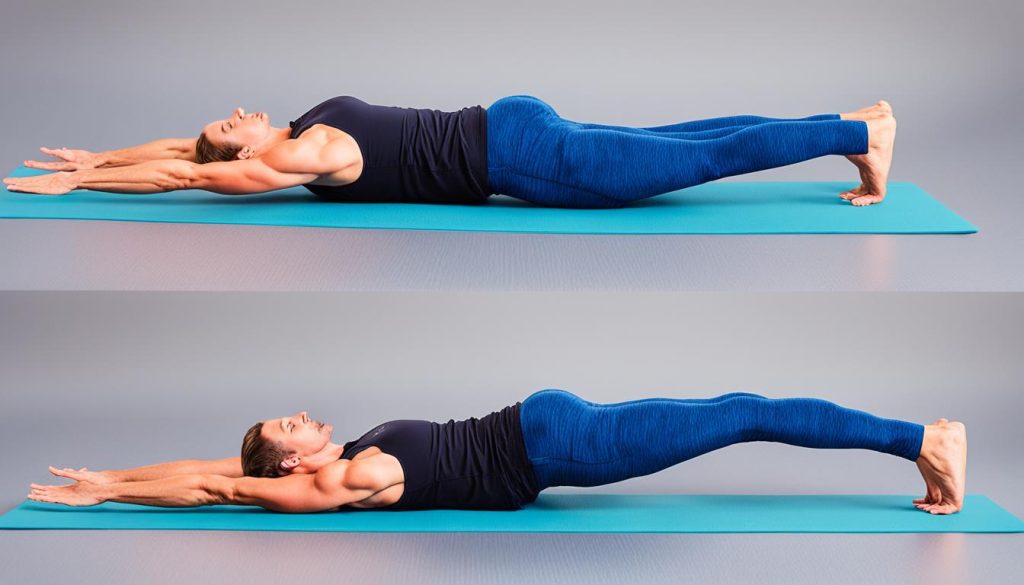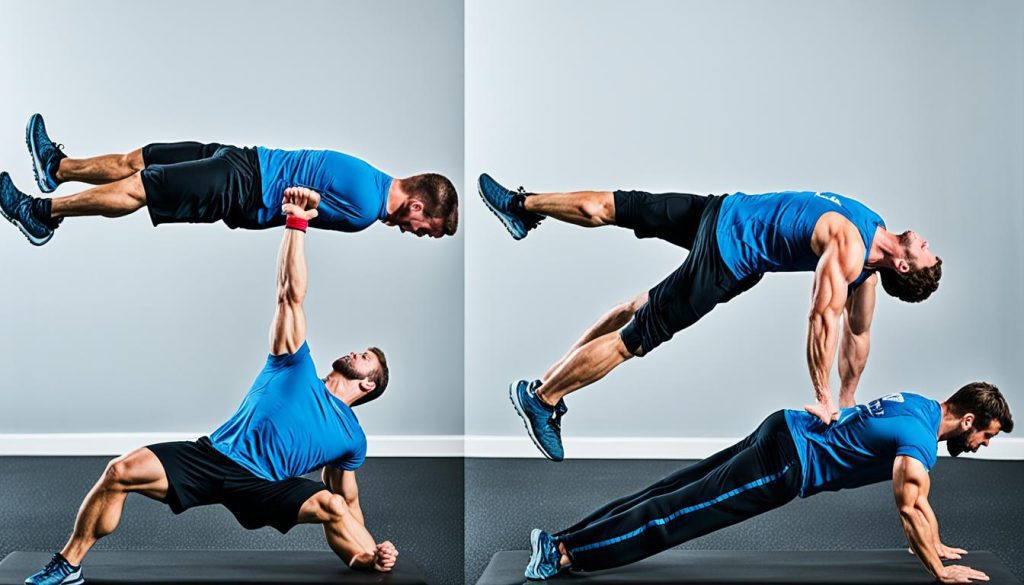Greetings, fitness enthusiasts! Today, I want to introduce you to a powerful exercise called the reverse plank. This challenging yet rewarding pose, also known as Upward Plank Pose or Purvottanasana, targets your entire body, allowing you to build core strength and enhance your flexibility.
Let’s dive into the benefits and variations of the reverse plank exercise, as well as the correct form and technique for optimal results.
How to Reverse Plank
- Learn how to perform the reverse plank step-by-step.
- Understand the benefits of incorporating the reverse plank into your workout routine.
- Discover variations and alternatives to keep your exercise regimen engaging.
- Ensure proper form and technique to maximize the effectiveness of the reverse plank.
- Consult with a qualified professional for guidance and personalized modifications.
Reverse Plank Step-by-Step Instructions
To perform the reverse plank, start by sitting in Dandasana (Staff Pose) with legs extended forward and hands next to the hips. Flex the ankles and press forward with the big toe mounds. Lean back slightly and slide the hands back about 8 inches.
Inhale to move the shoulder blades in and lift the chest. Exhale to point the feet, reach towards the floor with the big toe mounds, and lift the hips. Keep pressing towards the floor with the big toe mounds, engaging the inner thighs and directing the buttocks towards the backs of the knees.
Hold for 5-10 breaths and release back to the floor.
Modifications and progressions can be done to suit different levels of strength and flexibility, and it is important to maintain proper form throughout the exercise.
- Modifications: If you struggle to lift your hips, you can start by bending your knees and keeping your feet flat on the ground. As you gain strength, gradually extend your legs.
- Progressions: To challenge yourself further, you can try lifting one leg off the ground and holding the reverse plank on one leg. You can also lift one arm off the ground and hold the pose with one arm extended. These variations increase the intensity and engage additional muscles.
- Proper form: When performing a reverse plank, make sure to keep your core engaged, shoulders rolled back, and chest lifted. Avoid sinking into the shoulders or letting your head drop.
Benefits of Reverse Plank
Reverse plank offers a wide range of benefits. It strengthens the arms, wrists, and legs while stretching the shoulders, chest, and front ankles. The technique of reverse plank is quite simple, making it accessible for beginners, yet it can also be progressed to challenge more experienced practitioners.
One of the main benefits of reverse plank is that it improves core strength and stability. By engaging the abdominal muscles, lower back, and glutes, the pose helps to enhance overall body balance and alignment.
Another advantage of reverse plank is its ability to correct muscle imbalances caused by repetitive chest and shoulder strengthening exercises. By counteracting the forward flexion of these exercises, reverse plank helps to open up the chest, stretch the shoulder muscles, and promote better posture.
Furthermore, reverse plank is a versatile exercise that activates multiple muscle groups simultaneously. In addition to the core, it also targets the triceps, quadriceps, and hamstrings, providing a full-body workout.
For beginners, reverse plank can be a great addition to their workout routine. It can be modified to suit individual needs and gradually progressed as strength and flexibility improve. The pose can be practiced at home without the need for any special equipment, making it convenient for those who prefer to exercise in their own space.
By incorporating reverse plank into your regular fitness regimen, you can experience the numerous benefits it offers, including improved strength, flexibility, and posture. Remember to always practice proper form and consult a qualified instructor or fitness professional if you have any concerns or questions.

Benefits of Reverse Plank
- Strengthens the arms, wrists, and legs
- Stretches the shoulders, chest, and front ankles
- Improves core strength and stability
- Corrects muscle imbalances caused by chest and shoulder exercises
- Activates multiple muscle groups
- Promotes overall body balance and alignment
- Adaptable for beginners and advanced practitioners
- Can be performed at home without special equipment
Reverse Plank Variations and Alternatives
If you’re looking to add some variety and challenge to your exercise routine, there are several reverse plank variations and alternatives that you can try. These variations target the same muscle groups as the reverse plank and can be used to target specific goals or accommodate different fitness levels.
One popular variation is the reverse plank bridge. In this variation, you keep your feet flat on the ground instead of lifting them off the floor. This variation provides a different challenge to your core and lower body, making it a great option for those who want to mix things up.
Another variation that can be beneficial is the reverse plank on elbows. This variation reduces stress on the shoulders and places more emphasis on the triceps and core muscles. To perform this variation, start in a seated position with your legs extended forward, and place your elbows on the ground directly under your shoulders. Lift your hips off the ground while keeping your elbows and forearms on the floor.
If you’re not quite ready for the reverse plank or are just starting out, there are also beginner reverse plank exercises that you can try. These exercises target similar muscle groups and can help you build the strength and stability necessary for the reverse plank. Some beginner reverse plank exercises include the glute bridge, hip thrust, and glute-ham raise.
Remember, it’s important to listen to your body and choose a variation or alternative that suits your fitness level and goals. Whether you’re looking to challenge yourself or just starting out, these variations and alternatives can provide a fresh twist to your workout routine.
To visually enhance your understanding of reverse plank variations and alternatives, take a look at the image below:

Conclusion
Incorporating the reverse plank into your workout routine can greatly benefit your core strength and overall body fitness. This exercise engages multiple muscle groups, providing a challenging and effective way to strengthen your core. By practicing the reverse plank with proper form and technique, you can maximize the benefits and avoid potential injuries.
Regularly including reverse plank in your workout routine can help correct muscle imbalances caused by excessive chest and shoulder exercises. It targets the muscles in your arms, wrists, legs, shoulders, chest, and ankles, promoting balance and increased flexibility. The reverse plank also activates the core, which is essential for maintaining stability and preventing back pain.
To ensure you perform the reverse plank correctly, it’s advisable to seek guidance from a qualified yoga instructor or fitness professional. They can help you learn the proper form, identify any limitations, and provide recommendations for modifications and variations. Remember, proper form is crucial to avoid strain or injury and to achieve the desired results.
So, if you want to enhance your core strength, improve overall body fitness, and challenge yourself with a versatile and effective exercise, consider adding the reverse plank to your workout routine. With dedication and consistency, you’ll experience the benefits of this powerful exercise for your core strength, flexibility, and overall physical well-being.
FAQ
How do I perform a reverse plank?
To perform a reverse plank, start by sitting in Dandasana (Staff Pose) with legs extended forward and hands next to the hips. Flex the ankles and press forward with the big toe mounds. Lean back slightly and slide the hands back about 8 inches. Inhale to move the shoulder blades in and lift the chest. Exhale to point the feet, reach towards the floor with the big toe mounds, and lift the hips. Hold for 5-10 breaths and release back to the floor.
Are there any modifications or progressions for the reverse plank?
Yes, the reverse plank can be modified and progressed to suit different levels of strength and flexibility. Some modifications include using blocks under the hands for added support or bending the knees for less intensity. Progressions can be done by adding leg lifts or extending one leg for a more challenging variation.
What are the benefits of the reverse plank?
The reverse plank strengthens the arms, wrists, and legs while stretching the shoulders, chest, and front ankles. It also improves core strength, stability, and helps correct muscle imbalances caused by excessive chest and shoulder exercises.
Are there any variations or alternatives to the reverse plank?
Yes, there are several variations and alternatives to the reverse plank. Some variations include the reverse plank bridge and the reverse plank on elbows. Alternatives include exercises like the glute bridge, hip thrust, and glute-ham raise, which target similar muscle groups.




